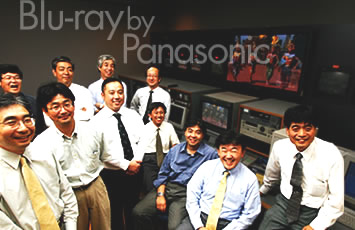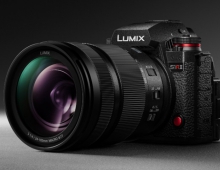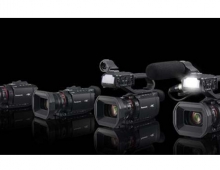
Panasonic Talks Blu-ray
As one of the first makers of 6x Blu-ray recordable discs and a basic developer of the Blu-ray disc technology, Panasonic has strong belief in the success in the format, talks about the challenges of the new 6x BD-R technology and comments on the reliability of the BD discs for archival purposes. We had the chance to talk with Mr. Hiroyuki Hasegawa, General manager of Technology Group, Media Business Unit, Device Business Group, at Panasonic Corp's AVC Networks Company and actually the man in charge of optical media engineering in Panasonic Japan. Mr. Hasegawa talked about the archival potential of Blu-ray discs, provided in formation about Panasonic's new BD-R SL (25GB) and DL (50GB) discs, commented on the possible success of the new LTH (Low-To-High) BD-R discs and finally expressed its belief that the Blu-ray disc format can be a future-proof successor of the DVD.
Q: What kind of materials are you using for the recording layer of the new 6x BD-R discs? Which are the critical parameters in choosing the right materials for the recording medium?
A: Both 4x BD-R and 6x BD-R are made of same typical phase change material of TeOPd, which enables native WORM (Write Once Read More) function. However, their structure design is different. Panasonic has long experience for this material system.

Q: Which are the main challenges you faced for making a 6x BD-R disc?
A: Mechanical properties such as servo characteristics are very tight in 6x BD-R specification. We carefully design the manufacturing process of both cover layer and space layer to reduce the roughness, which causes the unevenness on the surface of such layers.
Q: Could you comment on the recording quality of the 6x BD-Rs (RSER, jitter, reflectivity etc)?
A: The 6x BD-R achieves equivalent signal quality to 4x BD-R. For example, Random SER* is on the order of 1E-05 where the specification requires it less than 2.0E-4.
Q: Could you describe us the writing strategy of the laser while burning a BD-R SL and DL at 8x?
A: There are several drives which can write 8x speed to 6x BD-R media, but there is no current 8x BD-R specification. So far, we have heard no information to create an 8x BD-R specification. We are not in the position to comment on this issue.
Q: BD-RE discs are quite popular in Japan since they could easily used many times in Blu-ray stand-alone recorders. Which are the main differences/challenges in the development of a BD-RE compared to the BD-R discs?
A: One of the biggest challenges is to develop the recording material. In the BD-RE media, the information is recorded onto the disc by laser radiation of very short pulse by the method to control phase change between crystalline and amorphous. It is very important to choose appropriate material which is thermally stable in amorphous phase and has very rapid crystalline speed.
Another challenge is the material of the protective layer. No contamination is allowed to the protective layers located on both sides of recording layer to realize repeated recording as it is heated up more than 600 degree C in the recording process. Stability and good adhesion with the recording layer is also required from the aspect of reliability in high temperature and high humidity environment.
Q: There has been a lot of discussion around the longevity of BD-R media. Although the various hard coating technologies promise high durability, the nature of the Blu-ray disc technology makes it extremely sensitive, according to our tests. For example, a simple fingerprint on the surface of the disc could skyrocket the digital errors reported for the specific disc. Do you think that a 6x BD-R disc is reliable for long lasting archival?
A: Panasonic believes that both reliability and longevity are very
important characteristics for optical media. Panasonic chooses
inorganic material for recording layer as it has superior reliability.
From our environmental acceleration test, Panasonic BD-R shows archival reliability of more than fifty (50) years. Also it is very important to realize anti-finger-print characteristics. Panasonic employs hard coating for media surface to realize AFP property and will continue to improve this property.
Q: Do you think that the 8x speed will be the highest for BD-R? Which are main challenges for creating such a disc? Should we expect a 12x BD-R in the near future?
A: It is essential to improve mechanical properties of the media for 12x speed media, but it seems possible to develop 12x speed BD-R in the future. On the other hand, from the point of drive motor capability, 12x can be achieved only at the very outer diameter area, so that the advantage of 12x might be limited. Further study from the point of business must be done for this issue.
Q: Do you believe that the LTH BD-R media will become mainstream in the future? Will it also support writing speeds higher than 2x?
A: We think that the most important requirements for optical disc media are the followings:
(1) high throughput,
(2) high capacity (dual layer),
(3) low cost,
(4) longevity,
(5) light resistance.
Panasonic chooses inorganic material as recording layer because it is
suitable from these points. LTH media in the market now only achieves 2x
speed, 25GB capacity, and its price is same as inorganic media. It
utilizes organic dye like DVD-R, but the structure of the media is not
as simple as DVD-R media. As a result, there is no big cost advantage in
the manufacturing process compared with inorganic BD-R media. As it uses
organic dye, light resistance is not as good as inorganic BD-R media.
Additionally, there are certain hardware products that don’t support LtH media because of poor availability. Consequently Panasonic doesn’t think LtH media will become a mainstream product for Blu-ray.
Q: Do you believe that the Blu-ray will be the successor of the DVD in the PC segment? Are the flash memory solutions 'threatening' Blu-ray?
A: Both drive cost and media cost are important factors to succeed in the PC segment. It is obvious that Blu-ray would be the successor of DVD when the drive cost becomes affordable in the future. NAND flash memory has following features different from optical disc:
(1) reasonable cost,
(2) small dimension,
(3) vibration resistance,
(4) capacity.
This NAND flash memory has the different roll and application regarding the previously indicated features. From the aspect of high capacity, media distribution and archive use, optical media have the advantage.
Q: When should we expect more affordable blank Blu-ray discs on the market?
A: Don’t you think it is already affordable? For the case of rewritable
media, the GB cost of BD-RE is already less than that of DVD-RAM. For
the case of recordable media, the GB cost of BD-R is slightly more than
that of DVD-R right now, but the day will come soon. Refer to Japanese
market data, the market price of BD-R marks a sharp decline of one third
and the market size of BD-R/RE media grows twelve times larger in the
last twelve months. Panasonic will make the best effort to realize the same
situation in the European market.
*The Random Symbol Error Rate (RSER)is defined as the Symbol Error Rate where all erroneous bytes contained in burst errors of which the length is ≥ 40 bytes are excluded from counting in the numerator as well in the denominator of the SER calculation. The RSER value is calculated over 10,000 LDC Blocks.
Such errors can be caused by all optical defects that interfere with the normal data read-out procedure (scratches, dots, black spots, bubbles, etc). Local defects can cause the data contents to deteriorate. Others causes can be jitter problems, stamper defects or a bad HF signal.
For additional information see our "Blu-ray writing quality" article





















